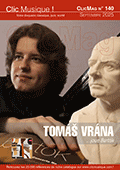|
|
|
Diapason from April 2015
Review de Jean-Luc Macia
Page No. 95
Format : 1 CD
Total Time : 01:12:48
Recording : 2011-2013
Location : Loughton/Londres
Country : Royaume-Uni
Sound : Eglise / Stereo
Label : Hyperion
Catalog No. : CDA68097
EAN : 0034571280974
Price Code : DM022A
Publishing Year : 2015
Release Date : 18/03/2015
Genre : Classical
|
|
 |
Wolfgang Amadeus Mozart (1756-1791)
Concerto pour cor n° 2 en mi bémol majeur, K. 417
Concerto pour cor n° 4 en mi bémol majeur, K. 495
Concerto pour cor n° 3 en mi bémol majeur, K. 447
Concerto pour cor n° 1 en ré majeur, K. 412
Quintette pour cor en mi bémol majeur, K. 407
Pip Eastop, cor naturel
Quatuor Eroica
The Hanover Band
Anthony Halstead, direction
|
 
|
Les Concertos pour cor de Mozart sont probablement les œuvres les plus célèbres jamais écrites pour cet instrument. Ce nouvel album regroupe toutes les œuvres que Mozart composa pour son ami de toujours, le corniste Joseph Leutgeb (1732-1811), l'un des meilleurs de l'époque. Dans ces cinq pièces, Mozart parvient à capturer le caractère de cet instrument souvent associé à la chasse; il en profite pour le ramener à l'intérieur: les épisodes lyriques, particulièrement les mouvements lents, soulignent l'âme même de l'instrument, malgré les limites perceptibles du cor sans pistons. Leutgeb devait être un digne destinataire de ces merveilleuses œuvres. Son successeur moderne sur cor naturel est le corniste Pip Eastop, dont les capacités techniques et l'inventivité musicale sont manifestes dans ces interprétations hautement plaisantes. Il est accompagné par l'ensemble The Hanover Band et Tony Halstead (ce dernier a fourni la fin du Concerto nº 2 en mi bémol majeur, K 417, inachevé).  Mozart’s Horn Concertos are perhaps the most popular works ever written for the instrument. This new album is a collection of all the works Mozart wrote for his lifelong friend, the horn player Joseph Leutgeb (1732–1811), one of the foremost players of his day. In these five works Mozart captures the public persona of an instrument most readily associated with all things hunting, but he also brings it indoors: lyrical episodes, and especially the slow movements, show the very soul of the instrument, despite any perceived limitations of the valveless horn. Leutgeb must indeed have been a worthy recipient of these fine works. His modern successor is natural horn player Pip Eastop, whose technical ability and musical inventiveness are palpable in these hugely enjoyable renditions. He is accompanied by The Hanover Band and Tony Halstead (who has also provided an ending for the unfinished K417, Horn Concerto No 2 in E flat major).
|
| . |
 |
|
|
